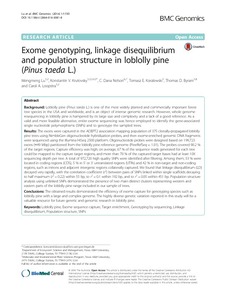Показать сокращенную информацию
Exome genotyping, linkage disequilibrium and population structure in loblolly pine (Pinus taeda L.)
| Автор | Lu, M. | |
| Автор | Krutovsky, K. V. | |
| Автор | Nelson, C. D. | |
| Автор | Koralewski, T. E. | |
| Автор | Byram, T. D. | |
| Автор | Loopstra, C. A. | |
| Дата внесения | 2016-11-11T08:49:10Z | |
| Дата, когда ресурс стал доступен | 2016-11-11T08:49:10Z | |
| Дата публикации | 2016 | |
| Библиографическое описание | Lu, M. Exome genotyping, linkage disequilibrium and population structure in loblolly pine (Pinus taeda L.) [Текст] / M. Lu, K. V. Krutovsky, C. D. Nelson, T. E. Koralewski, T. D. Byram, C. A. Loopstra // BMC Genomics. — 2016. — Т. 17 (№ 17). — С. 1-11 | |
| ISSN | 14712164 | |
| URI (для ссылок/цитирований) | https://elib.sfu-kras.ru/handle/2311/27824 | |
| Аннотация | Background: Loblolly pine (Pinus taeda L.) is one of the most widely planted and commercially important forest tree species in the USA and worldwide, and is an object of intense genomic research. However, whole genome resequencing in loblolly pine is hampered by its large size and complexity and a lack of a good reference. As a valid and more feasible alternative, entire exome sequencing was hence employed to identify the gene-associated single nucleotide polymorphisms (SNPs) and to genotype the sampled trees. Results: The exons were captured in the ADEPT2 association mapping population of 375 clonally-propagated loblolly pine trees using NimbleGen oligonucleotide hybridization probes, and then exome-enriched genomic DNA fragments were sequenced using the Illumina HiSeq 2500 platform. Oligonucleotide probes were designed based on 199,723 exons (≈49 Mbp) partitioned from the loblolly pine reference genome (PineRefSeq v. 1.01). The probes covered 90.2 % of the target regions. Capture efficiency was high; on average, 67 % of the sequence reads generated for each tree could be mapped to the capture target regions, and more than 70 % of the captured target bases had at least 10X sequencing depth per tree. A total of 972,720 high quality SNPs were identified after filtering. Among them, 53 % were located in coding regions (CDS), 5 % in 5' or 3' untranslated regions (UTRs) and 42 % in non-target and non-coding regions, such as introns and adjacent intergenic regions collaterally captured. We found that linkage disequilibrium (LD) decayed very rapidly, with the correlation coefficient (r2) between pairs of SNPs linked within single scaffolds decaying to half maximum (r2 = 0.22) within 55 bp, to r2 = 0.1 within 192 bp, and to r2 = 0.05 within 451 bp. Population structure analysis using unlinked SNPs demonstrated the presence of two main distinct clusters representing western and eastern parts of the loblolly pine range included in our sample of trees. Conclusions: The obtained results demonstrated the efficiency of exome capture for genotyping species such as loblolly pine with a large and complex genome. The highly diverse genetic variation reported in this study will be a valuable resource for future genetic and genomic research in loblolly pine. | |
| Ссылка на другой сайт | http://www.biomedcentral.com/content/pdf/s12864-016-3081-8.pdf | |
| Тема | Loblolly pine | |
| Тема | Exome sequence capture | |
| Тема | Target enrichment | |
| Тема | Genotyping by sequencing | |
| Тема | Linkage disequilibrium | |
| Тема | Population structure | |
| Тема | SNPs | |
| Название | Exome genotyping, linkage disequilibrium and population structure in loblolly pine (Pinus taeda L.) | |
| Тип | Journal Article | |
| Тип | Published Journal Article | |
| Страницы | 1-11 | |
| ГРНТИ | 34.23 | |
| Дата обновления | 2016-11-11T08:49:10Z | |
| DOI | 10.1186/s12864-016-3081 | |
| Институт | Институт фундаментальной биологии и биотехнологии | |
| Подразделение | Базовая кафедра защиты и современных технологии мониторинга лесов | |
| Журнал | BMC Genomics | |
| Квартиль журнала в Scopus | Q1 | |
| Квартиль журнала в Web of Science | Q1 |

